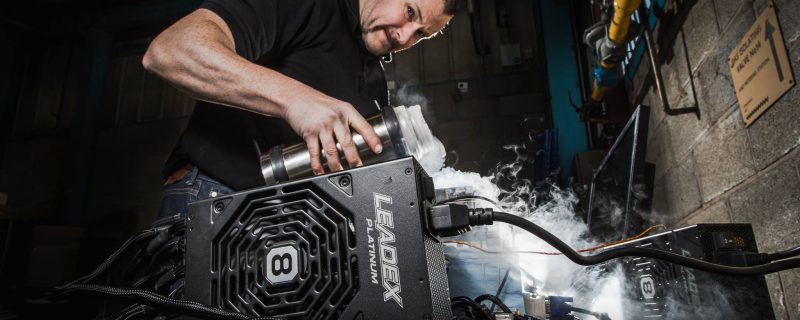
First and second installment of this articles provoked quite a discussion. Today we present you third part that should make the series complete.
Combining PSUs
With the 1500 W, 1600W and even 2000 W units on the market today, there is no need to combine power supplies—unless you’re an extreme overclocker.
Believe me, extremely overclocked high-end graphic cards are capable of consuming absurd amounts of energy. R9 290X or GTX 780 Ti with GPU running at 1600 MHz for Radeon and 2000 MHz for GeForce can draw about 800 W. And I am talking only about the card. Now imagine a setup with four cards like that, plus a CPU with a monstrous appetite for power.
In such scenarios, overclockers usually use one PSU for the mainboard plus peripherals and one PSU for each GPU. And every PSU has to be 1000 W or stronger, with a single 12 V rail. Multiple 12 V rails just wouldn’t work when you have to transfer 800 W through two 8-pin PCI Express connectors. This is also why separate and thick wires for each PCI Express connector pin could be useful.
But back to the main topic: there are two ways to create a multi-PSU setup.
- Create or buy an extender that connects the green and black cables of 24-pin ribbons (although I recommend more black GND cables to be used).

- Use a switch that detects voltage from eg. a 4-pin Molex connector from the “mother” supply and based on that shorts green and black cables on other units. This is more sophisticated method that eliminates unwanted extender from main 24-pin ribbon.
Fact: Green cable has the symbol PS_ON#, and shortening it turns on the PSU.
Hold-up time
After the power is out in the socket, there is usually a brief moment after the PC shuts down that is called the hold-up time.
ATX specifications say that the minimum hold-up time of a fully loaded PSU should be 17 ms. The longer the hold-up time, the better.
If the quality of the power line feeding your house is very poor and you’re certain your PC shuts down because of short pauses in the power delivery, a very strong, high-quality PSU might solve your problem—though I would still recommend buying a UPS.
Please note: hold-up time is not an easy parameter to measure and usually lower quality PSUs can’t achieve result from an ATX specification.
Inrush current
After you plug the PSU into the power socket and turn on the power, the power draw spikes briefly. The PFC capacitor(s) are loaded during this process. And if the power draw is too high, it may trip the circuit breakers in your house.
While this problem mainly plagued older high-wattage units, the lower the inrush current, the better. Even a very powerful power supply can be designed in such a way that the inrush current won’t be a problem.
Please note: If your PSU trips your circuit breakers because the inrush current is too high, you may try switching them to a model with lower sensitivity. The later the letter in the alphabet, the lower the sensitivity. The number after the letter indicate max amperage (read more here). In Europe, B16 circuit breakers are pretty much the standard in households, but switching to C16 should be ok. However, please consult and conduct any changes with guidance from a professional electrician.
Real producers
There are fewer power supply producers than you might think. Most companies just buy ready units and apply some minor changes.
Below there is a list of PSU producers (left) and vendors who buy units from them (right). It is not complete, but it should show you how things are. Order is alphabetical.
CWT – Cooler Master, Corsair, Enermax, Thermaltake
Delta – Antec
Enhance – Cooler Master, Corsair, Silverstone, Thermaltake
FSP (Fortron) – BeQuiet!
GreatWall – Corsair
Seasonic – Antec, Cooler Master, XFX
Sirfa – Silverstone, Zalman
Super Flower – EVGA
PSU topologies
Four groups of PSUs can be distinguished, based on how they are built and operate.
- Analog controller with group regulation – used in cheaper units, doesn’t handle crossload well.
- Analog controller with separate rail regulation – used in more decent PSUs.
- Analog controller with DC-DC converters – used in better and most high-end units.
- Digital controller with DC-DC converters – used in most expensive and sophisticated units.
In theory, a PSU with a digital controller should be superior to analog controlled ones. In reality, well-designed and well-made analog units with DC-DC converters are able to keep up with, or even surpass, them.
Good to know: Crossload occurs when the load on one type of rail is very high and on others very low—for example, 20 A on a 3.3 V rail and only 1 A on a 12 V rail. While such a situation in real life is rather unlikely, good quality PSUs handle it very well. In low-quality units, voltages can go out of the ATX specification during crossload.
Additional features
Power meters
PSUs can be equipped with parameter-monitoring meters. This can be done by adding an additional panel or, if the PSU is digitally controlled, dedicated software could do it. Just don’t expect high accuracy from these readings—more of an overview than reliable numbers.
LED
If you don’t like things glowing inside your case, pay attention to whether the PSU has LED lightning. After all, in today’s world, it isn’t only fans that can be illuminated. There are modular connectors with LEDs too.
On the other hand, if you are an illumination enthusiast, there are units with RGB lighting available.
Bluetooth
Digitally controlled units can be packed with loads of features. Even with a Bluetooth module onboard, the PSU can connect through a smartphone app. It could enable you to control the lights, fan mode and to monitor temperatures, volts or amps.
White paintjob
If you want a white-themed PC or just something that stands out, some vendors offer white editions of their PSUs.
The Power cable
To be precise, it is rather hard to call it a feature. It’s more like issue to be aware of. The majority of PSUs use a standard C13 power plug. But some more powerful units utilize a C19 connector. It makes no difference until you need a replacement or try to install such a PSU in case where you need a power cord extender.
Good to know: Read more about IEC plug standards here.
Warning: The presence of both a C13 plug and a C14 plug indicates the PSU is completely outdated. The second plug powers the monitor. I advise you not to buy such a unit.
Voltage regulation and ripple
Voltage regulation and ripple are extremely important parameters.
The power supply must consistently maintain stable voltages, no matter the load. Voltages that are too high fry computers while too low voltages will cause shut-downs.
Possible deviations are specified by the ATX standard, but of course the smaller the deviation the better. The best PSUs on the market have a voltage regulation offering less than 1% deviation on most important 12 V rail(s).
| Output | Tolerance | Minimum | Maximum |
| +12 VDC | +/- 5% | +11,40 V | +12,60 V |
| +5 VDC | +/- 5% | +4,75 V | +5,25 V |
| +3,3 VDC | +/- 5% | +3,14 V | +3,47 V |
| -12 VDC | +/- 10% | -10,80 V | -13,20 V |
| +5 VSB | +/- 5% | +4,75 V | +5,25 V |
Ripple, unfortunately, is the hardest parameter to measure. Oscilloscope is needed and it is neither cheap nor easy to operate. Generally speaking, the lower the ripple, the better and prolonged exposure of hardware to high ripple will damage it.
| Output | Max Ripple and Noise (mVpp) |
| +12 VDC | 120 |
| +5 VDC | 50 |
| +3,3 VDC | 50 |
| -12 VDC | 120 |
| +5 VSB | 50 |
Wattage
I left one of the most important issues for last on purpose. When it comes to choosing your PSU, most people concentrate on wattage along. But as this article should by now have driven home, there’s a good deal more to consider…
The most important rule is not to choose a power supply that is just barely sufficient for your PC.
- The internal parts of the PSU (the capacitors) wear out over time and, after a few years, your power supply could not be able to deliver the power it did when it was brand new. We aren’t talking about big numbers here, but you should be aware of that.
- A PSU working near maximum load will degrade fast.
- There is always an efficiency sweetspot and some users buy PSU considering this factor.
Based on that, choose a unit that is a bit more powerful than your PC really needs. Also some headroom could come in handy if you decide to upgrade to more power-hungry components. Just don’t go over the top and equip a simple office PC with a 750 W unit.
Nowadays a 550 W PSU is more than ample to power up even a high-end PC with one GPU.
600 W or stronger power supplies are only needed for older hardware, multi-GPU setups, extreme overclocking or other specific needs.
Please note: Specific scenarios – running AVX applications on Intel CPUs, for example, or mining on graphic cards – can cause much higher power draw than “normal” usage does. Take that into account when choosing a PSU.
Good to know: Most online calculators (like this one) are not bad, but usually recommend a bit too strong PSU than is needed.
Good to know: The TDP parameter doesn’t indicate directly how much power hardware consumes, but is a guideline for choosing coolers. Be aware that Intel understands TDP slightly differently than AMD does, so this parameter is not comparable between these two brands.
What is a sweetspot? It is the point on the efficiency curve where the curve begins to fall. Usually it is somewhere around 60%.
Choose the PSU with parameters that best suit your needs. For example, if you are building a small server with a lot of hard drives, look for a unit with strong 3,3 V and 5 V lines.
Please note: Producers usually indicate that a very strong power supply is required to run their graphics cards. Those requirements are given with worst case scenario in mind—for example, a very power-hungry CPU combined with a low-quality PSU.
If you wish to estimate what PSU you need based on reviews, pay attention what kind of power draw the reviewers discuss. Power draw measured between the hardware and the PSU is what should interest you, not power draw measured between the PSU and the power socket in the wall.
Tests
Appropriate knowledge and appropriate gear are a must to conduct informative PSU reviews. Sadly, there is no lack of power supplies reviews done for which the editor doesn’t even bother to open the unit to examine it…
I’d recommend four sites where editors really know what they are doing and are equipped with good measuring tools. I personally like Jonny the most 🙂
Conclusion
You buy power supply once, and it shall last you a long time. After all, there is little left to improve, the room for new features being limited as it is. This is why PSUs don’t become outdated quickly. In any case, I’d urge you not to make your choice on price alone. Usually it is worth laying out a little extra to get the higher quality. Quality units can keep your computer running for more than 10 years. Given the large selection of very different models, do choose wisely.

































